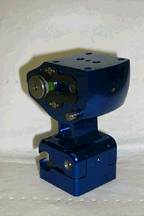‘All of my friends there dream of having prostheses like these,’ writes Russian amputee
A letter expressing "deepest gratitude" from a Russian landmine victim fitted with a newly developed artificial foot demonstrates one reason for the initiation of a second prosthetics project between Sandia and the Ohio Willow Wood Company.

Download 150dpi JPEG image, ‘knee_pix.jpg’, 1 Mb
This one, to develop an artificial knee, is supported by a $1.4 million cooperative research and development agreement (CRADA) from the DOE’s Initiatives for Proliferation Prevention Program.
The CRADA signing took place on Wednesday, July 28, at the Lockheed Martin Technology Innovation Center in Albuquerque. Officials from the Ohio Willow Wood Co. will match DOE-provided funds with in-kind work. They were expected to bring several types of artificial knee mechanisms to the signing for display purposes.
In a unique arrangement, technologies for foot and knee are being jointly developed by two nuclear weapons laboratories on opposite sides during the Cold War, Sandia and the Russian laboratory known as Chelyabinsk 70, in Snezhinsk, about 900 miles southeast of Moscow.
Ohio Willow Wood, located in Mount Sterling, Ohio, will define the requirements for parts and perform final laboratory and clinical testing. The Russians will come up with a titanium housing, and Sandia robotics researchers Mark Vaughn (1252) and Dave Kozlowski (15272) will design the knee’s internal workings and electronics. Sandia and the Russian nuclear lab will split their half of the funding.
"This work will have many benefits," says Sandia chemist and project leader Mort Lieberman (15413), who will also manage the Russian connection. "Someone in this world loses a limb to a landmine explosion every 20 minutes. Our work, though only remedial, will help landmine survivors and other amputees."
The work also provides work opportunities in areas of civilian need for Russian nuclear scientists. In an odd twist, "We will have created the world’s biggest research center for lower-limb prostheses in a Russian laboratory," says Mort.
The first collaboration, on an artificial foot, has reached the stage where the devices have been experimentally affixed to willing amputees. The improvement in motion over currently marketed prosthetic feet is such that "I am amazed by your invention," writes Russian amputee Sergei Burlakov. He reportedly now can walk the entire day without experiencing discomfort that formerly made him unable to wear a prosthesis for more than two or three hours. "At the institute where I have undergone my rehabilitation process, your Rolling Foot made a sensation," he wrote. And, in the unintentionally saddest of his sentences, ‘All of my friends and acquaintances there dream of having prostheses like these."
The current project will draw upon Sandia’s electronic expertise and Russian materials knowledge to create, respectively, the brains and shape of the knee.
"The work is a good fit with the capabilities of both labs," says Mort. "It involves stress analysis, mechanical testing, reliability testing, microprocessor control, and materials analysis."
It also helps out the prosthetics industry, which is dominated by small companies with relatively small technical support. While prosthetics companies certainly have worked to improve their devices, he says, they lack the resources to perform the types of testing possible at both nuclear laboratories.
A knee must be able to vary the speed of its response. Then it needs to lock so that its wearer doesn’t fall when standing. "The knee is not simply a hinge," says Mort. "If it were only that, it might swing back too far or not enough, letting the foot hit the ground too soon and causing its wearer to trip."
Other proposals related to prosthetics have been submitted by Sandia and Chelyabinsk 70 researchers to various funding organizations, he says. The proposals deal with the creation of sockets able to adjust to the swelling and shrinkage of an amputee’s stump during the course of the day, knees that help prevent falling when a wearer stumbles, and microprocessor-controlled prosthetics to obtain a more natural gait.
Mort serves on the executive board for the International Institute for the Prosthetic Rehabilitation of Landmine Survivors. He is also on the executive board of New Mexico Department of Health’s Disability Health Advisory Council and has been nominated to serve on the US Department of Education’s National Institute on Disability and Rehabilitation Research.
He credits the push that took place in technology transfer in the early 1990s for opening the door to applying weapons technology to other applications.